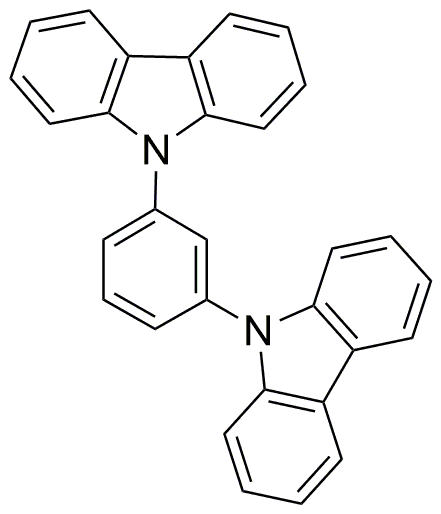1,3-Di-9-carbazolylbenzene is widely utilized in research focused on:
- Organic Light Emitting Diodes (OLEDs): This compound serves as an effective emitter material in OLEDs, enhancing light efficiency and color purity, which is crucial for the display and lighting industries.
- Organic Photovoltaics: It is used in the development of organic solar cells, where its excellent charge transport properties contribute to improved energy conversion efficiency.
- Fluorescent Sensors: The compound is employed in creating fluorescent sensors for detecting environmental pollutants or biological markers, providing a sensitive and selective detection method.
- Polymer Composites: It can be incorporated into polymer matrices to improve mechanical and thermal properties, making it valuable in materials science and engineering applications.
- Pharmaceutical Research: The compound's unique structure allows for exploration in drug development, particularly in targeting specific biological pathways, which can lead to innovative therapeutic agents.
General Information
Properties
Safety and Regulations
Applications
1,3-Di-9-carbazolylbenzene is widely utilized in research focused on:
- Organic Light Emitting Diodes (OLEDs): This compound serves as an effective emitter material in OLEDs, enhancing light efficiency and color purity, which is crucial for the display and lighting industries.
- Organic Photovoltaics: It is used in the development of organic solar cells, where its excellent charge transport properties contribute to improved energy conversion efficiency.
- Fluorescent Sensors: The compound is employed in creating fluorescent sensors for detecting environmental pollutants or biological markers, providing a sensitive and selective detection method.
- Polymer Composites: It can be incorporated into polymer matrices to improve mechanical and thermal properties, making it valuable in materials science and engineering applications.
- Pharmaceutical Research: The compound's unique structure allows for exploration in drug development, particularly in targeting specific biological pathways, which can lead to innovative therapeutic agents.
Documents
Safety Data Sheets (SDS)
The SDS provides comprehensive safety information on handling, storage, and disposal of the product.
Product Specification (PS)
The PS provides a comprehensive breakdown of the product’s properties, including chemical composition, physical state, purity, and storage requirements. It also details acceptable quality ranges and the product's intended applications.
Certificates of Analysis (COA)
Search for Certificates of Analysis (COA) by entering the products Lot Number. Lot and Batch Numbers can be found on a product’s label following the words ‘Lot’ or ‘Batch’.
*Catalog Number
*Lot Number
Certificates Of Origin (COO)
This COO confirms the country where the product was manufactured, and also details the materials and components used in it and whether it is derived from natural, synthetic, or other specific sources. This certificate may be required for customs, trade, and regulatory compliance.
*Catalog Number
*Lot Number
Safety Data Sheets (SDS)
The SDS provides comprehensive safety information on handling, storage, and disposal of the product.
DownloadProduct Specification (PS)
The PS provides a comprehensive breakdown of the product’s properties, including chemical composition, physical state, purity, and storage requirements. It also details acceptable quality ranges and the product's intended applications.
DownloadCertificates of Analysis (COA)
Search for Certificates of Analysis (COA) by entering the products Lot Number. Lot and Batch Numbers can be found on a product’s label following the words ‘Lot’ or ‘Batch’.
*Catalog Number
*Lot Number
Certificates Of Origin (COO)
This COO confirms the country where the product was manufactured, and also details the materials and components used in it and whether it is derived from natural, synthetic, or other specific sources. This certificate may be required for customs, trade, and regulatory compliance.


